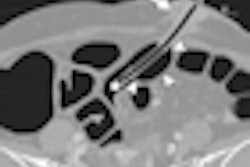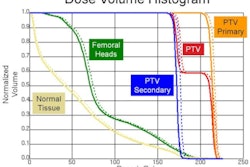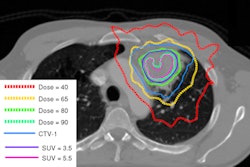Radiotherapy, with or without chemotherapy, is the preferred treatment for anal cancer because it preserves sphincter function. However, it's no guarantee that a patient will be spared having a colostomy, according to an article published online August 8 in the Journal of Clinical Oncology.
A Danish study of 235 patients treated for anal cancer between 1995 and 2003 showed that one-third of the patients required a colostomy after treatment. Toxicities attributed to radiation exposure created complications that necessitated a colostomy for 8% of the patients.
The study was initiated to assess cause-specific colostomy rates for a patient population, and to determine what percentage was therapy-related. The cohort included all patients whose treatment at four public hospitals in Denmark included curative-intent radiotherapy with a total radiation dose of more than 40 Gy. Patients were excluded from the study if they had received radiation therapy before or after an abdominoperineal rectal excision (J Clin Oncol, August 8, 2011).
For the patient group, the median age at radiotherapy was 60 (range, 31 to 89 years), and 79% of the patients were women. Thirty-eight percent of the patients had a tumor volume larger than 4 cm. The majority of patients (55%) had a T2 tumor classification, followed by T3 at 20%, T1 at 13%, and T4 at 12%. One-fourth of the patients had involvement of regional lymph nodes, and 12% had infiltration of adjacent organs.
The majority of patients received external-beam radiation therapy at a dose of 60 to 64 Gy, delivered in 2 Gy daily fractions over a six-week time period. Thirty-three patients (14%) received a brachytherapy boost, and 73 (31%) also had adjuvant chemotherapy treatments.
Dr. Kåre Sunesen, from the department of gastrointestinal surgery at Aalborg Hospital, and co-authors determined that the five-year incidence of tumor-related colostomy was 26%. Tumor-related colostomies, in which cancer was discovered, were performed within two years following radiotherapy for 89% of the patients, and within five years for all but three patients. Having tumors 6 cm or larger in size proved to be the greatest risk factor for colostomy, conveying a 3.8 times greater risk than tumors smaller than 4 cm.
Eighteen patients required colostomies due to what the authors described as bothersome local symptoms or suspicion of residual tumor from radiation exposure. The majority of these patients (83%) required the surgery within two years of treatment, and all had colostomies within five years. Two of these patients were subsequently able to have their colostomies reversed.
Patients who had a local excision or an excisional biopsy before radiotherapy had a more than fourfold higher incidence of therapy-related colostomy. Noting that other studies had also identified this factor, the authors recommended that local excisions not be performed, even for small tumors.
Another key finding was that no patient with a pretreatment colostomy was able to have it reversed. Patients should be advised that pretreatment colostomies are typically permanent, the authors recommended.



















